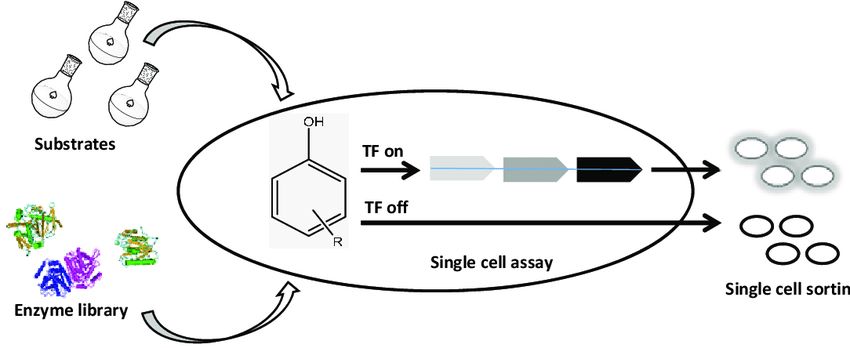Enzyme Library Construction is a method used to create a variety of enzyme variants. This is typically done by introducing genetic diversity into a particular gene and expressing these varied genes. The resulting enzyme library is a valuable resource for studying enzyme function, structure, and evolution. The construction of these libraries is essential as they allow researchers to screen and select enzymes with desirable traits, such as high stability, specific activity, or unique substrate specificity. These traits can be used for various industrial and biotechnological applications. Additionally, these libraries help us understand how enzymes evolve and adapt, contributing to our knowledge of molecular biology and biotechnology.
 Genetic Enzyme Screening System (Carlina Peña, et al., 2016)
Genetic Enzyme Screening System (Carlina Peña, et al., 2016)
Technical Route
Here is the technical route of Enzyme Library Construction. This technical route outlines the key steps involved in Enzyme Library Construction, from gene synthesis to screening host organisms, with the overarching goal of creating a diverse library of enzymes for various applications.
| Step Name |
Objective |
Description |
| Gene synthesis |
Create artificial genes for enzyme variants |
Assemble nucleotides in a specific order to construct the required genes synthetically. This intricate process demands a profound understanding of molecular biology and genetic engineering techniques. |
| Vector construction |
Insert synthesized genes into vectors |
Insert synthesized genes into vectors to form recombinant DNA molecules. Utilize advanced biotechnological tools to ensure accurate insertion, as it is crucial for the proper functioning of the genes within the vector. |
| Transformation into host organisms |
Transfer recombinant DNA into host organisms |
Transform the recombinant DNA molecules into host organisms, allowing them to express the enzymes. This step is pivotal as it enables enzyme production and study. The host organism acts as a biological factory, generating enzymes for further analysis and application. |
| Screening host organisms |
Identify and isolate host organisms with desired enzyme variants |
Screen the host organisms to pinpoint and separate those harboring the desired enzyme variants. This screening process is essential for the success of Enzyme Library Construction, requiring sophisticated techniques to ensure precise identification and isolation of target organisms. This step results in a collection of enzymes ready for study and potential application. |
Service Process
Our service process is designed to ensure maximum efficiency, effectiveness, and customer satisfaction. Here's how it works:
- Initial consultation: This is where we discuss with the client to understand their project requirements, objectives, and expectations. We believe that effective communication with our clients is the first step towards a successful project.
- Enzyme library design: Based on the client's requirements, we design the enzyme library. This involves careful planning and strategy to ensure that the library will be as comprehensive and relevant as possible.
- Generation of the enzyme library: With the design in place, we then generate the enzyme library using cutting-edge scientific methods. This is a crucial phase where our team of experts works diligently to ensure the successful creation of the enzyme library.
- Screening: After the library is generated, we screen it to identify the desired enzyme variants. This involves using sophisticated techniques to isolate the enzymes that match the client's requirements.
- Analysis and reporting: Once the screening is complete, we analyze the results and prepare a comprehensive report. This report is then shared with the client, providing them with a detailed overview of the project's outcomes.
We're here to assist you. If you have any questions, need more information, or would like to discuss a potential project, please don't hesitate to contact us. Our team is always eager to help and share our expertise.
Applications
The construction of enzyme libraries plays a crucial role in protein engineering, directed evolution, and numerous industries. These libraries allow for the generation of diverse enzyme variants customized to exhibit improved activity, specificity, and stability. They are indispensable for applications such as biocatalysis, drug discovery, and bioprocess optimization. Our efforts in enzyme library construction drive innovation in biotechnology, furnishing researchers and industries with a wide array of enzyme variants suitable for various applications.
| Application |
Description |
| Protein Engineering |
Enzyme library construction is vital in protein engineering for creating diverse enzyme variants with improved properties, such as enhanced activity, stability, or substrate specificity. These variants can be tailored for specific industrial applications, including biocatalysis, bioremediation, and pharmaceutical production. |
| Directed Evolution |
Enzyme library construction serves as a foundation for directed evolution approaches, enabling the iterative screening and selection of enzyme variants with desired traits. This method is widely used in the development of enzymes for various applications, including drug discovery, metabolic engineering, and environmental biotechnology. |
| Bioprocess Optimization |
Enzyme library construction facilitates bioprocess optimization by providing a pool of enzyme variants that can be screened and optimized for improved performance under specific process conditions. This approach enhances the efficiency and productivity of biotechnological processes, such as biofuel production, food processing, and waste treatment. |
| Biosensor Development |
Enzyme libraries are utilized in biosensor development to identify enzymes with high specificity and sensitivity towards target analytes. These enzymes serve as the biorecognition elements in biosensors, enabling rapid and accurate detection of various compounds for applications in healthcare, environmental monitoring, and food safety. |
| Structural Biology |
Enzyme library construction is employed in structural biology studies to explore enzyme structure-function relationships and elucidate the molecular mechanisms underlying enzyme catalysis. By analyzing diverse enzyme variants from libraries, researchers gain insights into enzyme evolution, dynamics, and regulation, facilitating rational enzyme design and engineering. |
FAQs
We recognize that Enzyme Cofactor Engineering might provoke numerous inquiries. Therefore, we've gathered a series of commonly asked questions regarding this topic. If you don't find the answer you're looking for, feel free to reach out to us.
Q: What is the purpose of Enzyme Library Construction?
A: The purpose of Enzyme Library Construction is to create a diverse collection of enzymes. This collection serves as a rich resource for studying the functionalities of enzymes, thereby enhancing our understanding, and potentially leading to the development of innovative applications.
Q: What fields benefit from Enzyme Library Construction?
A: Several fields benefit from Enzyme Library Construction, including, but not limited to, medicine, biotechnology, and environmental science. The knowledge and insights gained from these studies can foster innovation and advancement across these fields.
Q: What is involved in the technical route of Enzyme Library Construction?
A: The technical route involves several steps, including gene synthesis, vector construction, transformation into host organisms, and screening for enzyme variants. Each process is conducted with meticulous detail to ensure the successful creation of an enzyme library.
Q: How long does the Enzyme Library Construction process take?
A: The duration of the process can vary depending on the complexity and scale of the project. Each project is unique, and we strive to complete it in the most efficient and effective manner without compromising on the quality of results.
Q: What are the potential applications of the enzymes derived from the library?
A: The potential applications of these enzymes are vast and far-reaching. They can be instrumental in drug development, biofuel production, waste management, and more. The enzymes derived from the library can solve complex problems and drive innovation in a variety of fields.
Q: Is the Enzyme Library Construction process safe?
A: Yes, every procedure in the Enzyme Library Construction process is conducted following strict safety guidelines. This ensures the security and safety of the process, the researchers, and the environment.

































 Genetic Enzyme Screening System (Carlina Peña, et al., 2016)
Genetic Enzyme Screening System (Carlina Peña, et al., 2016)